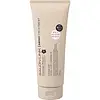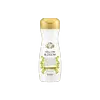What's inside
What's inside
 Key Ingredients
Key Ingredients

 Benefits
Benefits

 Concerns
Concerns

 Ingredients Side-by-side
Ingredients Side-by-side

Water
Skin ConditioningSorbitol
HumectantStearyl Alcohol
EmollientCetearyl Alcohol
EmollientGlycerin
HumectantDipropylene Glycol
HumectantDimethicone
EmollientAmodimethicone
Aminopropyl Dimethicone
Behentrimonium Chloride
PreservativeStearoxypropyltrimonium Chloride
CleansingPolyquaternium-7
Lysine Hcl
Skin ConditioningAlanine
MaskingHistidine Hcl
Skin ConditioningArginine
MaskingSerine
MaskingProline
Skin ConditioningGlutamic Acid
HumectantThreonine
Valine
MaskingLeucine
Skin ConditioningGlycine
BufferingIsoleucine
Skin ConditioningPhenylalanine
MaskingCystine
MaskingMethionine
Skin ConditioningTryptophan
MaskingAllantoin
Skin ConditioningTaurine
BufferingCamellia Seed Oil
Camellia Sinensis Seed Extract
HumectantCeramide Ng
Skin ConditioningArgania Spinosa Kernel Oil
EmollientSodium Hyaluronate
HumectantHydrolyzed Silk
HumectantButylene Glycol
HumectantIsopropyl Alcohol
SolventCitric Acid
BufferingMethylparaben
PreservativeEthylparaben
PreservativeParfum
MaskingWater, Sorbitol, Stearyl Alcohol, Cetearyl Alcohol, Glycerin, Dipropylene Glycol, Dimethicone, Amodimethicone, Aminopropyl Dimethicone, Behentrimonium Chloride, Stearoxypropyltrimonium Chloride, Polyquaternium-7, Lysine Hcl, Alanine, Histidine Hcl, Arginine, Serine, Proline, Glutamic Acid, Threonine, Valine, Leucine, Glycine, Isoleucine, Phenylalanine, Cystine, Methionine, Tryptophan, Allantoin, Taurine, Camellia Seed Oil, Camellia Sinensis Seed Extract, Ceramide Ng, Argania Spinosa Kernel Oil, Sodium Hyaluronate, Hydrolyzed Silk, Butylene Glycol, Isopropyl Alcohol, Citric Acid, Methylparaben, Ethylparaben, Parfum
Water
Skin ConditioningCyclopentasiloxane
EmollientCetyl Alcohol
EmollientStearyl Alcohol
EmollientStearamidopropyl Dimethylamine
EmulsifyingParfum
MaskingBrassica Napus Seed Oil
EmollientGlutamic Acid
HumectantDimethicone
EmollientPersea Gratissima Oil
Skin ConditioningPanax Ginseng Root Extract
EmollientPhenoxyethanol
PreservativeHouttuynia Cordata Extract
Skin ConditioningSalicylic Acid
MaskingPanthenol
Skin ConditioningAmodimethicone
Niacinamide
SmoothingGanoderma Lucidum Extract
Skin ProtectingButylene Glycol
HumectantGinkgo Biloba Leaf Extract
Skin ConditioningDisodium EDTA
Tocopheryl Acetate
AntioxidantCetrimonium Chloride
AntimicrobialCyclotetrasiloxane
EmollientLavandula Angustifolia Flower Water
Skin ConditioningHydrolyzed Keratin
HumectantTrideceth-12
EmulsifyingCitrus Paradisi Fruit Extract
Skin ConditioningPinus Sylvestris Cone Extract
MaskingCitrus Limon Fruit Extract
MaskingArtemisia Vulgaris Extract
Skin ConditioningAlcohol
AntimicrobialPyrus Malus Fruit Extract
Skin ConditioningAloe Barbadensis Leaf Extract
EmollientCoix Lacryma-Jobi Ma-Yuen Seed Extract
Skin ConditioningCalendula Officinalis Extract
Skin ConditioningRosmarinus Officinalis Extract
AntimicrobialSalvia Officinalis Extract
AntimicrobialWater, Cyclopentasiloxane, Cetyl Alcohol, Stearyl Alcohol, Stearamidopropyl Dimethylamine, Parfum, Brassica Napus Seed Oil, Glutamic Acid, Dimethicone, Persea Gratissima Oil, Panax Ginseng Root Extract, Phenoxyethanol, Houttuynia Cordata Extract, Salicylic Acid, Panthenol, Amodimethicone, Niacinamide, Ganoderma Lucidum Extract, Butylene Glycol, Ginkgo Biloba Leaf Extract, Disodium EDTA, Tocopheryl Acetate, Cetrimonium Chloride, Cyclotetrasiloxane, Lavandula Angustifolia Flower Water, Hydrolyzed Keratin, Trideceth-12, Citrus Paradisi Fruit Extract, Pinus Sylvestris Cone Extract, Citrus Limon Fruit Extract, Artemisia Vulgaris Extract, Alcohol, Pyrus Malus Fruit Extract, Aloe Barbadensis Leaf Extract, Coix Lacryma-Jobi Ma-Yuen Seed Extract, Calendula Officinalis Extract, Rosmarinus Officinalis Extract, Salvia Officinalis Extract
Ingredients Explained
These ingredients are found in both products.
Ingredients higher up in an ingredient list are typically present in a larger amount.
This water-soluble silicone is used for its hydrating and softening properties. It is used to add a silky feel to skincare products and has great benefits for haircare.
In haircare, this ingredient:
- Adds shine
- Protects color
- Offers thermal protection
- Boosts hair strength
- Does not build up as easily
Butylene Glycol (or BG) is used within cosmetic products for a few different reasons:
Overall, Butylene Glycol is a safe and well-rounded ingredient that works well with other ingredients.
Though this ingredient works well with most skin types, some people with sensitive skin may experience a reaction such as allergic rashes, closed comedones, or itchiness.
Learn more about Butylene GlycolDimethicone is a type of synthetic silicone created from natural materials such as quartz.
What it does:
Dimethicone comes in different viscosities:
Depending on the viscosity, dimethicone has different properties.
Ingredients lists don't always show which type is used, so we recommend reaching out to the brand if you have questions about the viscosity.
This ingredient is unlikely to cause irritation because it does not get absorbed into skin. However, people with silicone allergies should be careful about using this ingredient.
Note: Dimethicone may contribute to pilling. This is because it is not oil or water soluble, so pilling may occur when layered with products. When mixed with heavy oils in a formula, the outcome is also quite greasy.
Learn more about DimethiconeGlutamic Acid is an amino acid that is found in all living organisms. Our bodies use this to help nerve cells in the brain communicate with other cells.
In cosmetics, glutamic acid is a famous humectant. It draws water from the air to your skin, keeping your skin hydrated (like hyaluronic acid).
An in-vitro study from 2024 found glutamic acid to play a role in inhibiting inflammation and thus a potential skin-soothing ingredient.
Other studies show it to be have potential wound healing, skin barrier repair, and hair growth properties.
Glutamic acid has poor solubility in water and other solvents.
Learn more about Glutamic AcidParfum is a catch-all term for an ingredient or more that is used to give a scent to products.
Also called "fragrance", this ingredient can be a blend of hundreds of chemicals or plant oils. This means every product with "fragrance" or "parfum" in the ingredients list is a different mixture.
For instance, Habanolide is a proprietary trade name for a specific aroma chemical. When used as a fragrance ingredient in cosmetics, most aroma chemicals fall under the broad labeling category of “FRAGRANCE” or “PARFUM” according to EU and US regulations.
The term 'parfum' or 'fragrance' is not regulated in many countries. In many cases, it is up to the brand to define this term.
For instance, many brands choose to label themselves as "fragrance-free" because they are not using synthetic fragrances. However, their products may still contain ingredients such as essential oils that are considered a fragrance by INCI standards.
One example is Calendula flower extract. Calendula is an essential oil that still imparts a scent or 'fragrance'.
Depending on the blend, the ingredients in the mixture can cause allergies and sensitivities on the skin. Some ingredients that are known EU allergens include linalool and citronellol.
Parfum can also be used to mask or cover an unpleasant scent.
The bottom line is: not all fragrances/parfum/ingredients are created equally. If you are worried about fragrances, we recommend taking a closer look at an ingredient. And of course, we always recommend speaking with a professional.
Learn more about ParfumStearyl Alcohol is a type of fatty alcohol from stearic acid. It is a white, waxy compound used to emulsify ingredients.
Fatty Alcohols are most often used as an emollient or to thicken a product. Emollients help soothe and hydrate the skin by trapping moisture.
They are usually derived from natural fats and oils and therefore do not have the same drying or irritating effect as solvent alcohols. FDA allows products labeled "alcohol-free" to have fatty alcohols.
Learn more about Stearyl AlcoholWater. It's the most common cosmetic ingredient of all. You'll usually see it at the top of ingredient lists, meaning that it makes up the largest part of the product.
So why is it so popular? Water most often acts as a solvent - this means that it helps dissolve other ingredients into the formulation.
You'll also recognize water as that liquid we all need to stay alive. If you see this, drink a glass of water. Stay hydrated!
Learn more about Water